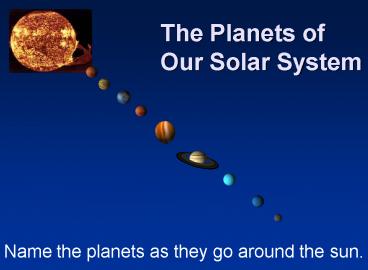The Inner Planets of Our Solar System - PowerPoint PPT Presentation
1 / 33
Title:
The Inner Planets of Our Solar System
Description:
Pluto. Mercury. Venus. Mars. 4. Which Planet has extreme temperatures because of its atmosphere? ... Pluto. 7. Which planet rotates on its side? Jupiter ... – PowerPoint PPT presentation
Number of Views:843
Avg rating:3.0/5.0
Title: The Inner Planets of Our Solar System
1
The Planets of Our Solar System
Name the planets as they go around the sun.
2
The Relative Sizes of the Planets and the Sun
NOT TO SCALE!
3
Facts
- Each one rotates and revolves
- Rotation the time it takes to spin on its axis
- Revolution the time it takes to orbit the sun
once
4
The Inner Planets
- Terrestrial Planets - have a rocky surface
- Mercury, Venus, Earth and Mars
5
Mercury
- Mercury is the closest planet to the sun.
- Has no moons.
- Extreme temperatures due to the extremely thin
atmosphere.
6
Venus
Venus rotates in a direction opposite that of
Earth, which means that if you were standing on
Venus, you would see the sun rising in the west
and setting in the east.
7
Venus
- Venus is also known as Earths twin.
- It is known as the morning and evening star.
- It is the hottest planet because of its thick
atmosphere which does not allow heat to escape
very well. - Never sees a sunny day.
8
Earth
- Earth is the only planet in our solar system that
contains life. - 70 of the Earth is covered with water.
- Only Planet with liquid water.
9
Mars
Mars is also called, the Red Planet. It is most
Earth-like of all the planets.
10
Mars
- Known as the red planet
- Has a northern ice cap and a cap in the south
which is frozen carbon dioxide - It does have different seasons
- Mars has 2 moons
- Phobos
- Deimos
11
Review of the Inner Planets
- What is the meaning of terrestrial?
- An alien being
- Without a surface
- Rocky, solid surface
- Snow covered
12
- 2. Which Planet is the hottest?
- Mercury
- Venus
- Earth
- Mars
13
- 3. Other than Earth, which planet has seasons?
- Pluto
- Mercury
- Venus
- Mars
14
- 4. Which Planet has extreme temperatures because
of its atmosphere? - Mercury
- Venus
- Mars
- the sun
15
- 5. Which Planet is known as Earths twin?
- Mercury
- Venus
- Mars
- the moon
16
The Outer Planets
- Jupiter, Saturn, Uranus, Neptune, and Pluto
- Gas Giants (except Pluto)
- All have rings except Pluto
- 1 more planet????
17
Jupiter
Jupiter has 27 moons.
18
Jupiter
- The largest planet in our solar system
- Has a great red spot that is thought to be a
storm. - Has colorful bands of thick clouds.
19
Saturn
Saturn, the sixth planet from the sun, is one of
the five planets visible from Earth without a
telescope.
20
Saturn
- The second largest planet in our solar system
- It has visible rings that can be seen from Earth
21
Uranus
Looks Blue because of the methane that is found
in its atmosphere.
22
Uranus
- Uranus rotates on its side
- Sideways Planet
- Tipped Uranus behaves as a giant top as it spins
on an axis almost in the plane of its orbit. This
motion leads to extreme seasonal variation in
what sunlight is available.
23
Neptune
- Neptune used to have a great dark spot like
Jupiter, but is no longer visible.
Neptune orbits the Sun every 165 years.
24
Pluto
PLUTO is the smallest, coldest, and the farthest
from the Sun.
25
Pluto
- Solid surface
- Rocky Planet
- Some scientists debate whether it is truly a
planet or not - Has 1 moon Charon
- Crosses inside the orbit of Neptune.
26
10th Planet - XENA
- Slightly bigger and a little over twice as far as
Pluto (97AU compared to 40 AU for
Pluto)http//www.nasa.gov/mission_pages/hubble/hst
_xena_20060410.html
27
http//www.darkstar1.co.uk/xena.html
28
Kuiper Belt
And Beyond!
29
- 6. Which Planet is the largest?
- Jupiter
- Saturn
- Neptune
- Pluto
30
- 7. Which planet rotates on its side?
- Jupiter
- Saturn
- Uranus
- Neptune
31
- 8. Which planet has rings that are visible from
Earth? - Jupiter
- Saturn
- Uranus
- Neptune
32
- 9. Which planet is the only outer planet that is
not a gas giant? - Jupiter
- Saturn
- Neptune
- Pluto
33
- Which planet crosses the orbit of Uranus?
- Saturn
- Earth
- Pluto
- Neptune































